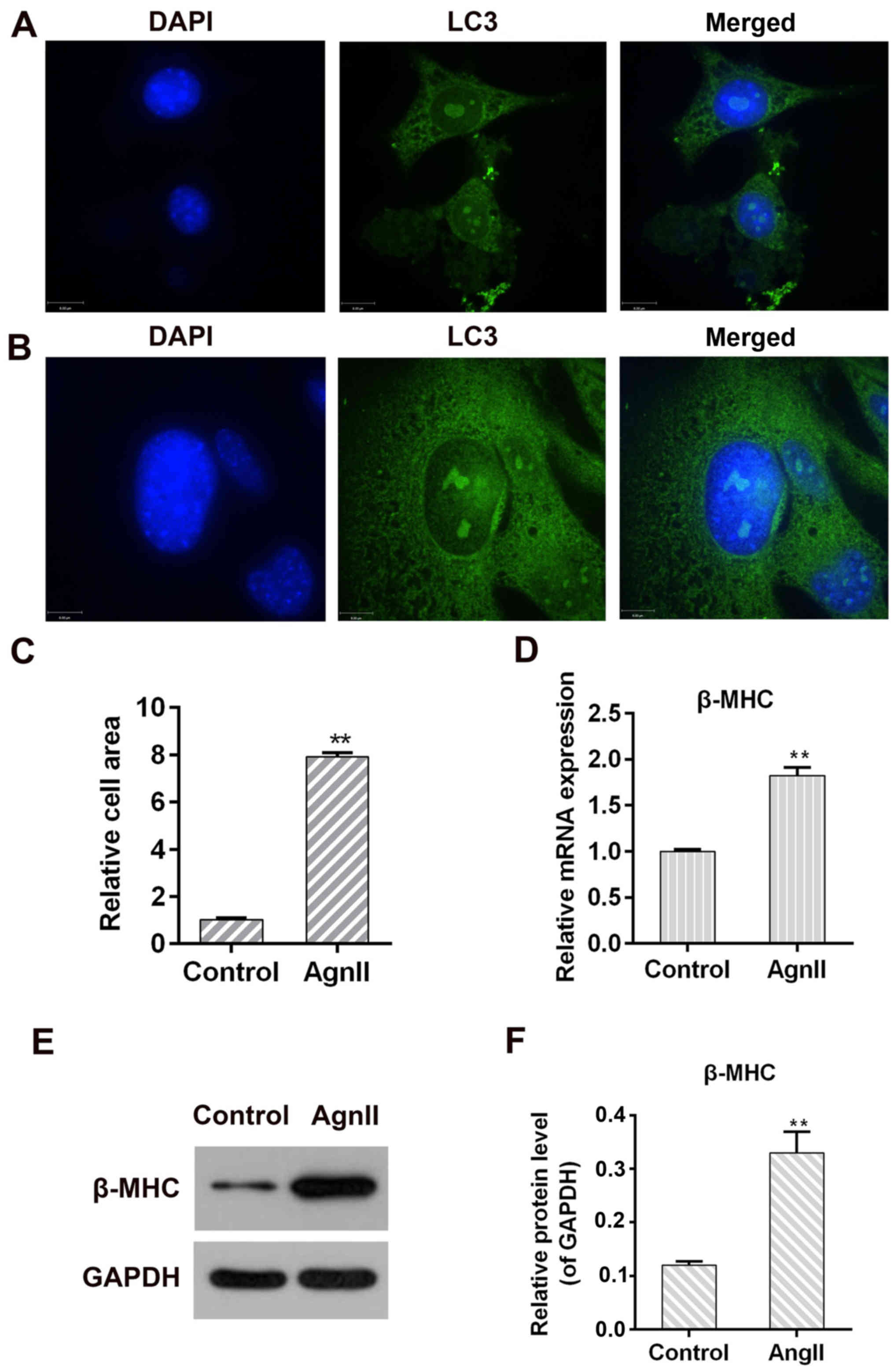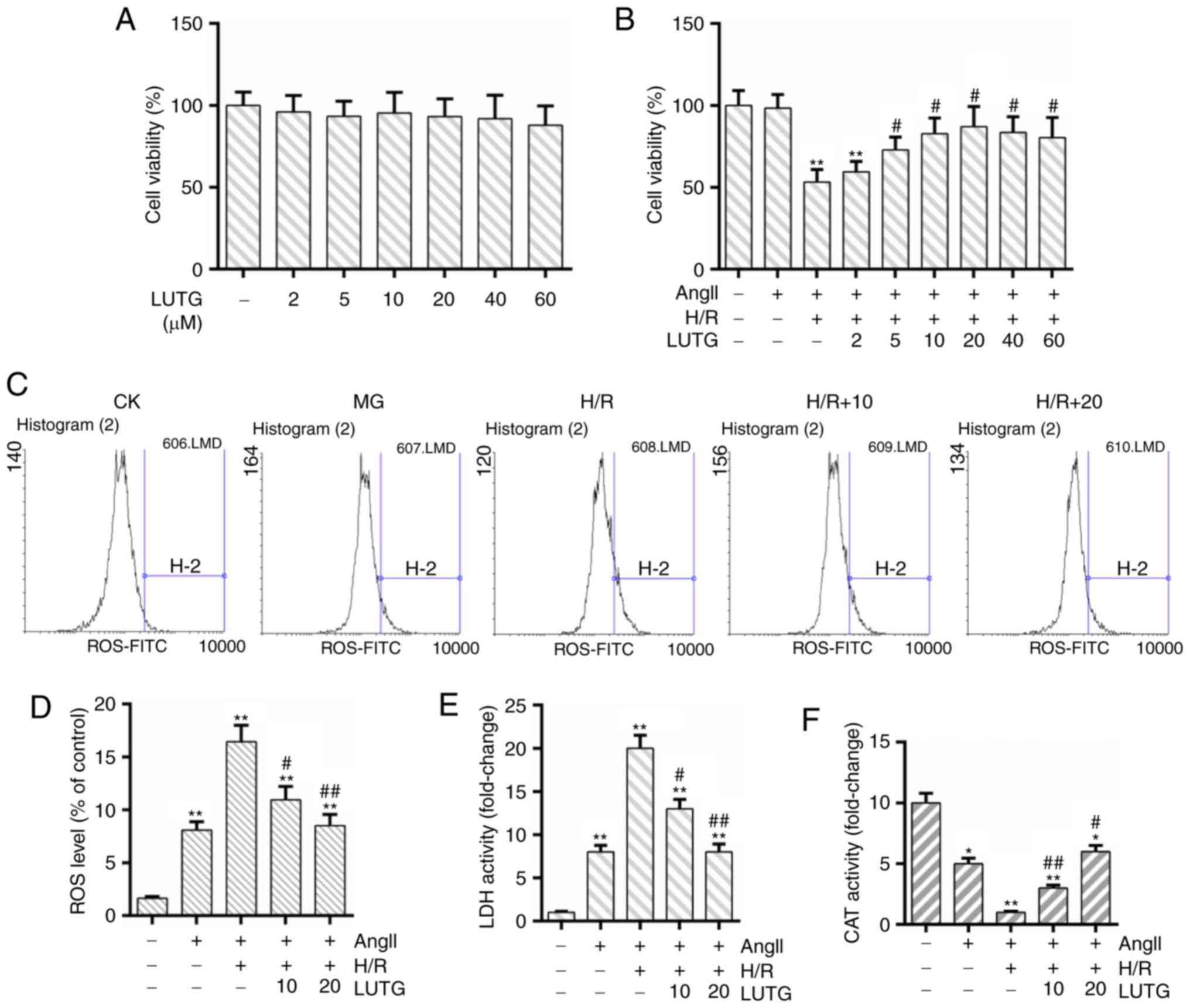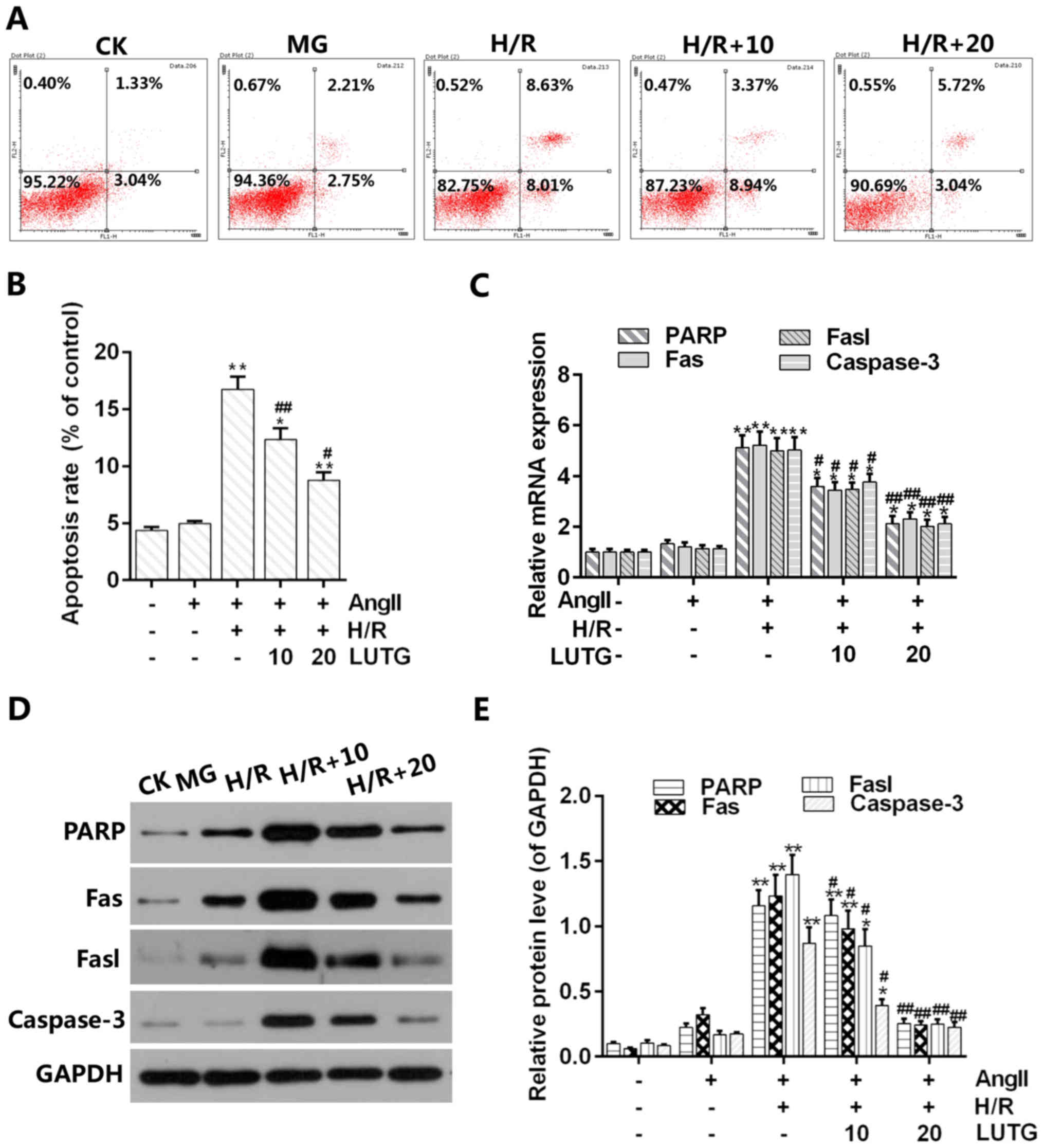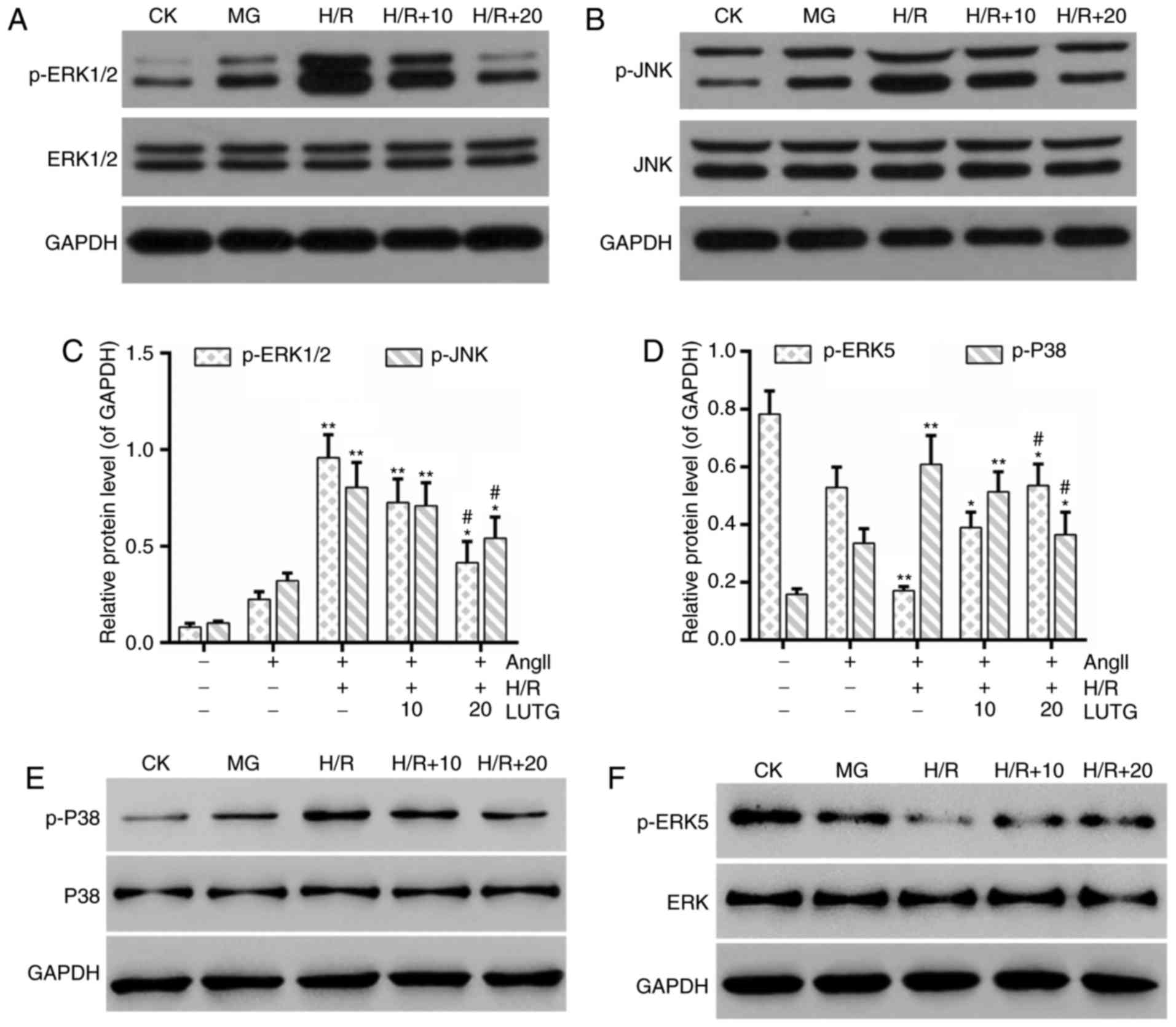|
1
|
Thygesen K, Alpert JS, Jaffe AS, Simoons
ML, Chaitman BR and White HD: Joint ESC/ACCF/AHA/WHF Task Force for
the Universal Definition of Myocardial Infarction, Katus HA,
Lindahl B, Morrow DA, et al: Third universal definition of
myocardial infarction. Circulation. 126:2020–2035. 2012. View Article : Google Scholar : PubMed/NCBI
|
|
2
|
Elrod JW, Calvert JW, Morrison J, Doeller
JE, Kraus DW, Tao L, Jiao X, Scalia R, Kiss L, Szabo C, et al:
Hydrogen sulfide attenuates myocardial ischemia-reperfusion injury
by preservation of mitochondrial function. Proc Natl Acad Sci USA.
104:pp. 15560–15565. 2007; View Article : Google Scholar : PubMed/NCBI
|
|
3
|
Wang SQ, Han XZ, Li X, Ren DM, Wang XN and
Lou HX: Flavonoids from Dracocephalum tanguticum and their
cardioprotective effects against doxorubicin-induced toxicity in
H9c2 cells. Bioorg Med Chem Lett. 20:6411–6415. 2010. View Article : Google Scholar : PubMed/NCBI
|
|
4
|
Anversa P, Ricci R and Olivetti G:
Quantitative structural analysis of the myocardium during
physiologic growth and induced cardiac hypertrophy: A review. J Am
Coll Cardiol. 7:1140–1149. 1986. View Article : Google Scholar : PubMed/NCBI
|
|
5
|
Fliss H and Gattinger D: Apoptosis in
ischemic and reperfused rat myocardium. Circ Res. 79:949–956. 1996.
View Article : Google Scholar : PubMed/NCBI
|
|
6
|
Islam BU, Habib S, Ahmad P, Allarakha S,
Moinuddin and Ali A: Pathophysiological role of peroxynitrite
induced DNA damage in human diseases: A special focus on poly
(ADP-ribose) polymerase (PARP). Indian J Clin Biochem. 30:368–385.
2015. View Article : Google Scholar : PubMed/NCBI
|
|
7
|
Gonzalez-Cuadrado S, Lorz C, Garcia del
Moral R, O'Valle F, Alonso C, Ramiro F, Ortiz-Gonzalez A, Egido J
and Ortiz A: Agonistic anti-Fas antibodies induce glomerular cell
apoptosis in mice in vivo. Kidney Int. 51:1739–1746. 1997.
View Article : Google Scholar : PubMed/NCBI
|
|
8
|
Gonzalez-Cuadrado S, Lopez-Armada MJ,
Gomez-Guerrero C, Subira D, Garcia-Sahuquillo A, Ortiz-Gonzalez A,
Neilson EG, Egido J and Ortiz A: Anti-Fas antibodies induce
cytolysis and apoptosis in cultured human mesangial cells. Kidney
Int. 49:1064–1070. 1996. View Article : Google Scholar : PubMed/NCBI
|
|
9
|
Dolka I, Krol M and Sapierzynski R:
Evaluation of apoptosis-associated protein (Bcl-2, Bax, cleaved
caspase-3 and p53) expression in canine mammary tumors: An
immunohistochemical and prognostic study. Res Vet Sci. 105:124–133.
2016. View Article : Google Scholar : PubMed/NCBI
|
|
10
|
Lu F, Xing J, Zhang X, Dong S, Zhao Y,
Wang L, Li H, Yang F, Xu C and Zhang W: Exogenous hydrogen sulfide
prevents cardiomyocyte apoptosis from cardiac hypertrophy induced
by isoproterenol. Mol Cell Biochem. 381:41–50. 2013. View Article : Google Scholar : PubMed/NCBI
|
|
11
|
Santin Y, Sicard P, Vigneron F,
Guilbeau-Frugier C, Dutaur M, Lairez O, Couderc B, Manni D,
Korolchuk VI, Lezoualc'h F, et al: Oxidative stress by monoamine
oxidase-A impairs transcription factor EB activation and
autophagosome clearance, leading to cardiomyocyte necrosis and
heart failure. Antioxid Redox Signal. 25:10–27. 2016. View Article : Google Scholar : PubMed/NCBI
|
|
12
|
Zhang RQ, Li DY, Xu TD, Zhu SS, Pan HJ,
Fang F, Wu X and Sun H: Antioxidative effect of luteolin
pretreatment on simulated ischemia/reperfusion injury in
cardiomyocyte and perfused rat heart. Chin J Integr Med.
23:518–527. 2017. View Article : Google Scholar : PubMed/NCBI
|
|
13
|
Jagadeesh GS, Nagoor Meeran MF and
Selvaraj P: Activation of beta1-adrenoceptor triggers oxidative
stress mediated myocardial membrane destabilization in
isoproterenol induced myocardial infarcted rats: 7-hydroxycoumarin
and its counter action. Eur J Pharmacol. 777:70–77. 2016.
View Article : Google Scholar : PubMed/NCBI
|
|
14
|
Lin Y, Shi R, Wang X and Shen HM:
Luteolin, a flavonoid with potential for cancer prevention and
therapy. Curr Cancer Drug Targets. 8:634–646. 2008. View Article : Google Scholar : PubMed/NCBI
|
|
15
|
Lee HZ, Yang WH, Bao BY and Lo PL:
Proteomic analysis reveals ATP-dependent steps and chaperones
involvement in luteolin-induced lung cancer CH27 cell apoptosis.
Eur J Pharmacol. 642:19–27. 2010. View Article : Google Scholar : PubMed/NCBI
|
|
16
|
Wolfle U, Esser PR, Simon-Haarhaus B,
Martin SF, Lademann J and Schempp CM: UVB-induced DNA damage,
generation of reactive oxygen species, and inflammation are
effectively attenuated by the flavonoid luteolin in vitro and in
vivo. Free Radic Biol Med. 50:1081–1093. 2011. View Article : Google Scholar : PubMed/NCBI
|
|
17
|
Chen CY, Peng WH, Tsai KD and Hsu SL:
Luteolin suppresses inflammation-associated gene expression by
blocking NF-kappaB and AP-1 activation pathway in mouse alveolar
macrophages. Life Sci. 81:1602–1614. 2007. View Article : Google Scholar : PubMed/NCBI
|
|
18
|
Chen HQ, Jin ZY, Wang XJ, Xu XM, Deng L
and Zhao JW: Luteolin protects dopaminergic neurons from
inflammation-induced injury through inhibition of microglial
activation. Neurosci Lett. 448:175–179. 2008. View Article : Google Scholar : PubMed/NCBI
|
|
19
|
Martin H, Flandez M, Nombela C and Molina
M: Protein phosphatases in MAPK signalling: We keep learning from
yeast. Mol Microbiol. 58:6–16. 2005. View Article : Google Scholar : PubMed/NCBI
|
|
20
|
Gerits N, Kostenko S and Moens U: In vivo
functions of mitogen-activated protein kinases: Conclusions from
knock-in and knock-out mice. Transgenic Res. 16:281–314. 2007.
View Article : Google Scholar : PubMed/NCBI
|
|
21
|
Baines CP and Molkentin JD: STRESS
signaling pathways that modulate cardiac myocyte apoptosis. J Mol
Cell Cardiol. 38:47–62. 2005. View Article : Google Scholar : PubMed/NCBI
|
|
22
|
Petrich BG and Wang Y: Stress-activated
MAP kinases in cardiac remodeling and heart failure; new insights
from transgenic studies. Trends Cardiovasc Med. 14:50–55. 2004.
View Article : Google Scholar : PubMed/NCBI
|
|
23
|
Frey N, Katus HA, Olson EN and Hill JA:
Hypertrophy of the heart: A new therapeutic target? Circulation.
109:1580–1589. 2004. View Article : Google Scholar : PubMed/NCBI
|
|
24
|
Mutlak M and Kehat I: Extracellular
signal-regulated kinases 1/2 as regulators of cardiac hypertrophy.
Front Pharmacol. 6:1492015. View Article : Google Scholar : PubMed/NCBI
|
|
25
|
Al-Rasheed NM, Al-Oteibi MM, Al-Manee RZ,
Al-Shareef SA, Al-Rasheed NM, Hasan IH, Mohamad RA and Mahmoud AM:
Simvastatin prevents isoproterenol-induced cardiac hypertrophy
through modulation of the JAK/STAT pathway. Drug Des Devel Ther.
9:3217–3229. 2015.PubMed/NCBI
|
|
26
|
Livak KJ and Schmittgen TD: Analysis of
relative gene expression data using real-time quantitative PCR and
the 2(-Delta Delta C(T)) method. Methods. 25:402–408. 2001.
View Article : Google Scholar : PubMed/NCBI
|
|
27
|
Yao H, Shang Z, Wang P, Li S, Zhang Q,
Tian H, Ren D and Han X: Protection of Luteolin-7-O-Glucoside
against doxorubicin-induced injury through PTEN/Akt and ERK pathway
in H9c2 cells. Cardiovasc Toxicol. 16:101–110. 2016. View Article : Google Scholar : PubMed/NCBI
|
|
28
|
Palombo R, Savini I, Avigliano L, Madonna
S, Cavani A, Albanesi C, Mauriello A, Melino G and Terrinoni A:
Luteolin-7-glucoside inhibits IL-22/STAT3 pathway, reducing
proliferation, acanthosis, and inflammation in keratinocytes and in
mouse psoriatic model. Cell Death Dis. 7:e23442016. View Article : Google Scholar : PubMed/NCBI
|
|
29
|
Zhao Y, Hu X, Liu Y, Dong S, Wen Z, He W,
Zhang S, Huang Q and Shi M: ROS signaling under metabolic stress:
Cross-talk between AMPK and AKT pathway. Mol Cancer. 16:792017.
View Article : Google Scholar : PubMed/NCBI
|
|
30
|
Han XZ, Gao S, Cheng YN, Sun YZ, Liu W,
Tang LL and Ren DM: Protective effect of naringenin-7-O-glucoside
against oxidative stress induced by doxorubicin in H9c2
cardiomyocytes. Biosci Trends. 6:19–25. 2012.PubMed/NCBI
|
|
31
|
Kirsch R and Kampf G: On the catlase
activity in rat Walker carcinoma. The effect of endoxan on
enzymatic activity. Arch Geschwulstforsch. 26:234–237.
1965.PubMed/NCBI
|
|
32
|
Bround MJ, Wambolt R, Luciani DS, Kulpa
JE, Rodrigues B, Brownsey RW, Allard MF and Johnson JD:
Cardiomyocyte ATP production, metabolic flexibility, and survival
require calcium flux through cardiac ryanodine receptors in vivo. J
Biol Chem. 288:18975–18986. 2013. View Article : Google Scholar : PubMed/NCBI
|
|
33
|
Sun Y, Ye L, Jiang C, Jiang J, Hong H and
Qiu L: Over-expression of HSPA12B protects mice against myocardium
ischemic/reperfusion injury through a PPARgamma-dependent
PI3K/Akt/eNOS pathway. Am J Transl Res. 7:2724–2737.
2015.PubMed/NCBI
|
|
34
|
Ozaki T, Yamashita T and Ishiguro S:
Mitochondrial m-calpain plays a role in the release of truncated
apoptosis-inducing factor from the mitochondria. Biochim Biophys
Acta. 1793:1848–1859. 2009. View Article : Google Scholar : PubMed/NCBI
|
|
35
|
Filippone EJ and Foy AJ: Blood pressure
management in the wake of SPRINT. Cleve Clin J Med. 83:196–198.
2016. View Article : Google Scholar : PubMed/NCBI
|
|
36
|
Shao M, Zhuo C, Jiang R, Chen G, Shan J,
Ping J, Tian H, Wang L, Lin C and Hu L: Protective effect of
hydrogen sulphide against myocardial hypertrophy in mice.
Oncotarget. 8:22344–22352. 2017. View Article : Google Scholar : PubMed/NCBI
|
|
37
|
Cave A, Grieve D, Johar S, Zhang M and
Shah AM: NADPH oxidase-derived reactive oxygen species in cardiac
pathophysiology. Philos Trans R Soc Lond B Biol Sci. 360:2327–2334.
2005. View Article : Google Scholar : PubMed/NCBI
|
|
38
|
Li JM, Gall NP, Grieve DJ, Chen M and Shah
AM: Activation of NADPH oxidase during progression of cardiac
hypertrophy to failure. Hypertension. 40:477–484. 2002. View Article : Google Scholar : PubMed/NCBI
|
|
39
|
Ko WG, Kang TH, Lee SJ, Kim YC and Lee BH:
Effects of luteolin on the inhibition of proliferation and
induction of apoptosis in human myeloid leukaemia cells. Phytother
Res. 16:295–298. 2002. View
Article : Google Scholar : PubMed/NCBI
|
|
40
|
Chen P, Zhang JY, Sha BB, Ma YE, Hu T, Ma
YC, Sun H, Shi JX, Dong ZM and Li P: Luteolin inhibits cell
proliferation and induces cell apoptosis via down-regulation of
mitochondrial membrane potential in esophageal carcinoma cells EC1
and KYSE450. Oncotarget. 8:27471–27480. 2017.PubMed/NCBI
|
|
41
|
Kang JH, Lee HS, Park D, Kang YW, Kim SM,
Gong JR and Cho KH: Context-independent essential regulatory
interactions for apoptosis and hypertrophy in the cardiac signaling
network. Sci Rep. 7:342017. View Article : Google Scholar : PubMed/NCBI
|
|
42
|
Wang Y: Mitogen-activated protein kinases
in heart development and diseases. Circulation. 116:1413–1423.
2007. View Article : Google Scholar : PubMed/NCBI
|
|
43
|
Sun J, Sun G, Meng X, Wang H, Luo Y, Qin
M, Ma B, Wang M, Cai D, Guo P, et al: Isorhamnetin protects against
doxorubicin-induced cardiotoxicity in vivo and in vitro. PloS One.
8:e645262013. View Article : Google Scholar : PubMed/NCBI
|
|
44
|
Miller WP, Ravi S, Martin TD, Kimball SR
and Dennis MD: Activation of the stress response kinase JNK (c-Jun
N-terminal kinase) attenuates insulin action in retina through a
p70S6K1-dependent mechanism. J Biol Chem. 292:1591–1602. 2017.
View Article : Google Scholar : PubMed/NCBI
|
|
45
|
Lorenzon A, Calore M, Poloni G, De Windt
LJ, Braghetta P and Rampazzo A: Wnt/beta-catenin pathway in
arrhythmogenic cardiomyopathy. Oncotarget. 8:60640–60655. 2017.
View Article : Google Scholar : PubMed/NCBI
|
|
46
|
Muthusamy VR, Kannan S, Sadhaasivam K,
Gounder SS, Davidson CJ, Boeheme C, Hoidal JR, Wang L and
Rajasekaran NS: Acute exercise stress activates Nrf2/ARE signaling
and promotes antioxidant mechanisms in the myocardium. Free Radic
Biol Med. 52:366–376. 2012. View Article : Google Scholar : PubMed/NCBI
|


















